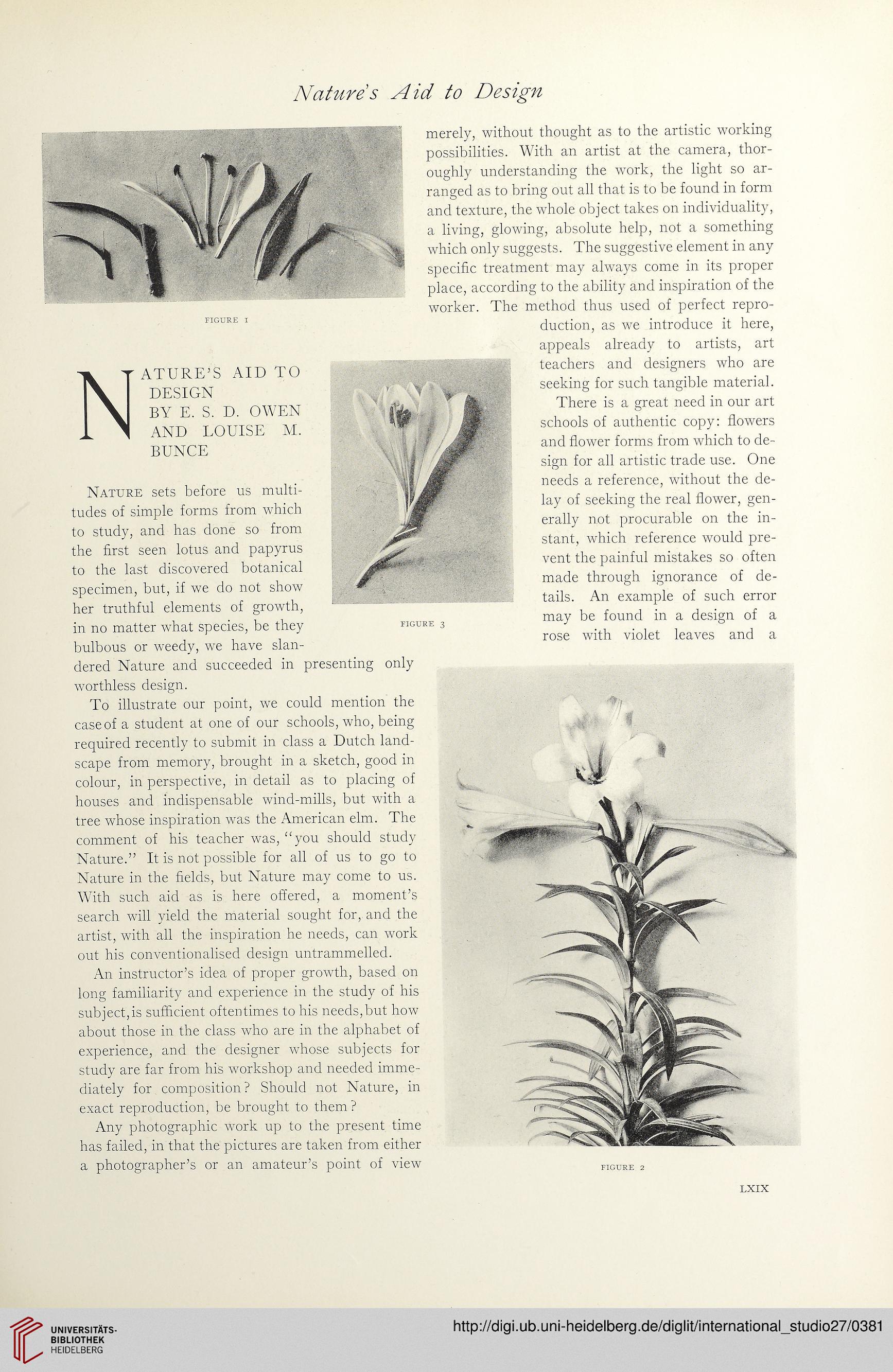Nature s Aid to Design
FIGüRE I
ATURE’S AID TO
DESIGN
BY E. S. D. OWEN
AND LOUISE M.
BUNCE
merely, without thought as to the artistic working
possibilities. With an artist at the camera, thor-
oughly understanding the work, the light so ar-
ranged as to bring out all that is to be found in form
and texture, the whole object takes on individuality,
a living, glowing, absolute help, not a something
which only suggests. The suggestive element in any
specific treatment may always come in its proper
place, according to the ability and Inspiration of the
worker. The method thus used of perfect repro-
duction, as we introduce it here,
appeals already to artists, art
teachers and designers who are
seeking for such tangible material.
There is a great need in our art
schools of authentic copy: flowers
and flower forms from which to de-
sign for all artistic trade use. One
needs a reference, without the de-
lay of seeking the real flower, gen-
erally not procurable on the in-
stant, which reference would pre-
vent the painful mistakes so often
made through ignorance of de-
tails. An example of such error
may be found in a design of a
rose with violet leaves and a
Nature sets before us multi-
tudes of simple forms from which
to study, and has done so from
the first seen lotus and papyrus
to the last discovered botanical
specimen, but, if we do not show
her truthful elements of growth,
in no matter what species, be they figu
bulbous or weedy, we have slan-
dered Nature and succeeded in presenting only
worthless design.
To illustrate our point, we could mention the
caseof a Student at one of our schools, who, being
required recently to submit in dass a Dutch land-
scape from memory, brought in a sketch, good in
colour, in perspective, in detail as to placing of
houses and indispensable wind-mills, but with a
tree whose inspiration was the American elm. The
comment of his teacher was, “you should study
Nature.” It is not possible for all of us to go to
Nature in the fields, but Nature may come to us.
With such aid as is here offered, a moment’s
search will yield the material sought for, and the
artist, with all the inspiration he needs, can work
out his conventionalised design untrammelled.
An instructor’s idea of proper growth, based on
long familiarity and experience in the study of his
subject,is sufficient oftentimes to his needs,but how
about those in the dass who are in the alphabet of
experience, and the designer whose subjects for
study are far from his workshop and needed imme-
diately for composition? Should not Nature, in
exact reprocluction, be brought to them?
Any photographic work up to the present time
has failed, in that the pictures are taken from either
a photographer’s or an amateur’s point of view
LXIX
FIGüRE I
ATURE’S AID TO
DESIGN
BY E. S. D. OWEN
AND LOUISE M.
BUNCE
merely, without thought as to the artistic working
possibilities. With an artist at the camera, thor-
oughly understanding the work, the light so ar-
ranged as to bring out all that is to be found in form
and texture, the whole object takes on individuality,
a living, glowing, absolute help, not a something
which only suggests. The suggestive element in any
specific treatment may always come in its proper
place, according to the ability and Inspiration of the
worker. The method thus used of perfect repro-
duction, as we introduce it here,
appeals already to artists, art
teachers and designers who are
seeking for such tangible material.
There is a great need in our art
schools of authentic copy: flowers
and flower forms from which to de-
sign for all artistic trade use. One
needs a reference, without the de-
lay of seeking the real flower, gen-
erally not procurable on the in-
stant, which reference would pre-
vent the painful mistakes so often
made through ignorance of de-
tails. An example of such error
may be found in a design of a
rose with violet leaves and a
Nature sets before us multi-
tudes of simple forms from which
to study, and has done so from
the first seen lotus and papyrus
to the last discovered botanical
specimen, but, if we do not show
her truthful elements of growth,
in no matter what species, be they figu
bulbous or weedy, we have slan-
dered Nature and succeeded in presenting only
worthless design.
To illustrate our point, we could mention the
caseof a Student at one of our schools, who, being
required recently to submit in dass a Dutch land-
scape from memory, brought in a sketch, good in
colour, in perspective, in detail as to placing of
houses and indispensable wind-mills, but with a
tree whose inspiration was the American elm. The
comment of his teacher was, “you should study
Nature.” It is not possible for all of us to go to
Nature in the fields, but Nature may come to us.
With such aid as is here offered, a moment’s
search will yield the material sought for, and the
artist, with all the inspiration he needs, can work
out his conventionalised design untrammelled.
An instructor’s idea of proper growth, based on
long familiarity and experience in the study of his
subject,is sufficient oftentimes to his needs,but how
about those in the dass who are in the alphabet of
experience, and the designer whose subjects for
study are far from his workshop and needed imme-
diately for composition? Should not Nature, in
exact reprocluction, be brought to them?
Any photographic work up to the present time
has failed, in that the pictures are taken from either
a photographer’s or an amateur’s point of view
LXIX




